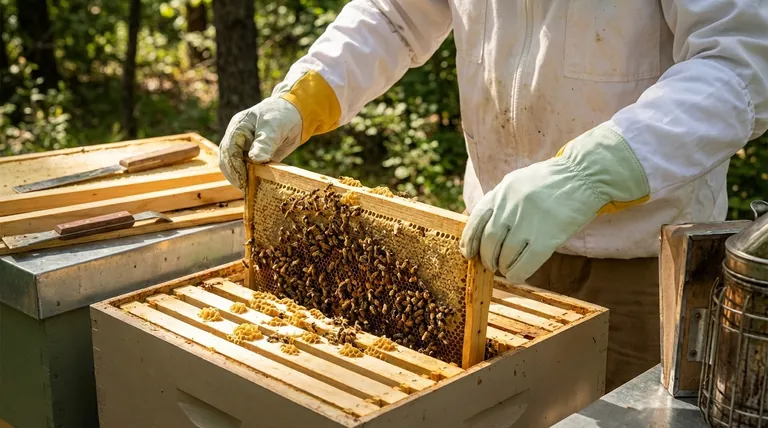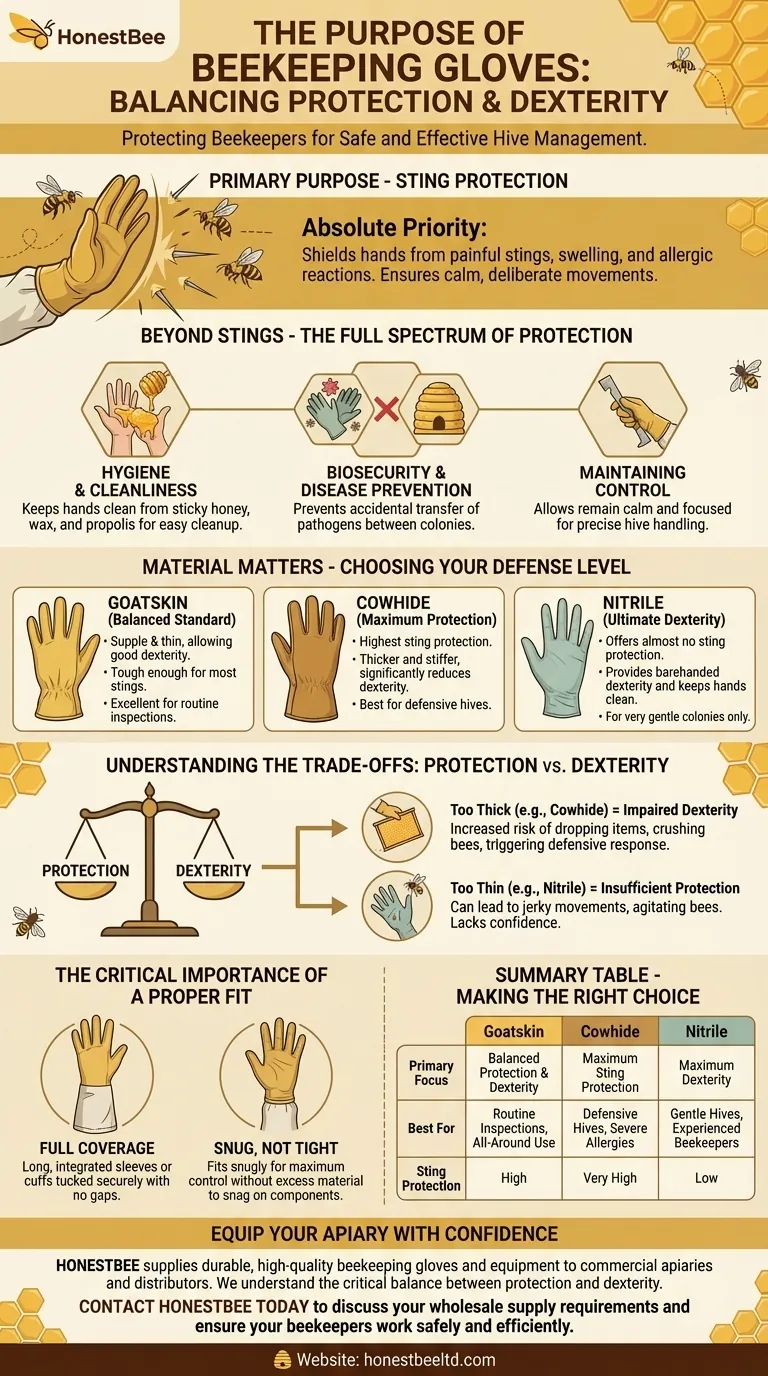The primary purpose of beekeeping gloves is to protect your hands from bee stings. Stings can cause significant pain, swelling, and allergic reactions, which reduce your ability to work safely and effectively. Beyond sting prevention, gloves also keep your hands clean from sticky honey and pollen and help prevent the spread of diseases between hives.
While sting protection is the absolute priority, the deeper challenge is finding a glove that balances this safety with the dexterity required to handle delicate hive components. The right glove is not just a shield; it is a tool that fosters confidence and precise control.

Beyond Stings: The Full Spectrum of Protection
Beekeeping gloves provide more than just a barrier against stingers. They are a foundational piece of personal protective equipment (PPE) that contributes to overall safety, hygiene, and hive health.
Preventing Stings and Maintaining Control
The most immediate benefit is shielding your hands and forearms from stings. A sting to the hand can cause swelling that severely limits mobility and fine motor skills, making it difficult to continue working in the hive. Proper protection allows you to remain calm and deliberate in your movements.
Ensuring Hive Hygiene
Working in a beehive is a sticky process. Gloves prevent honey, wax, and propolis from coating your hands, making cleanup significantly easier. This cleanliness is not just for your comfort; it's also crucial for biosecurity.
Preventing Disease Transmission
Clean gloves help prevent the accidental transfer of pathogens, such as bacteria or fungal spores, from one colony to another. Changing or cleaning gloves between hive inspections is a key practice in maintaining a healthy apiary.
Material Matters: Choosing Your Level of Defense
The material of your glove directly dictates the balance between protection and dexterity. There is no single "best" material; the right choice depends on your confidence level, hive temperament, and the task at hand.
Goatskin: The Balanced Standard
Goatskin is the most common and recommended material for most beekeepers. It is supple and relatively thin, allowing for good dexterity while still being tough enough to block most stings. This balance makes it an excellent all-around choice for routine inspections.
Cowhide: For Maximum Protection
Cowhide leather offers the highest level of sting protection. However, these gloves are thicker and stiffer, which significantly reduces your ability to feel and manipulate small items like frames or a queen cage. They are best reserved for working with highly defensive hives or for beekeepers with severe allergies where sting avoidance is paramount.
Nitrile: For Ultimate Dexterity
Disposable nitrile gloves offer almost no sting protection—a stinger can easily penetrate the material. However, they provide the same dexterity as working barehanded and keep your hands clean. Some experienced beekeepers use them with very gentle colonies, as the smooth surface can make bees less likely to land and sting.
Understanding the Trade-offs: Protection vs. Dexterity
Choosing a glove is a strategic decision that directly impacts your effectiveness as a beekeeper. Understanding the core trade-off is essential.
The Cost of Impaired Dexterity
Using a glove that is too thick, like cowhide, can make you clumsy. This increases the risk of dropping a frame or accidentally crushing bees, which can trigger a defensive response from the entire colony and lead to more stings.
The Risk of Insufficient Protection
Conversely, using a glove that is too thin can make you hesitant and fearful of stings. This can lead to jerky, uncertain movements, which are also known to agitate bees. The right glove instills the confidence needed for smooth, calm handling.
The Critical Importance of a Proper Fit
An ill-fitting glove can undermine its own purpose. A proper fit ensures both safety and functionality.
Full Coverage is Non-Negotiable
Gloves must have long, integrated sleeves or cuffs that extend well up the forearm. These cuffs should be tucked securely into your beekeeping suit or jacket, leaving no gaps for a curious bee to enter.
Snug, Not Tight
The glove should fit snugly around your hand and fingers without being restrictive. A proper fit eliminates loose, excess material that could snag on hive components, while ensuring you have maximum control and comfort for the duration of your inspection.
Making the Right Choice for Your Goal
Selecting the right glove is a personal decision based on your priorities and experience.
- If your primary focus is confidence and all-around use: Choose a pair of well-fitting goatskin gloves as your default choice.
- If your primary focus is maximum safety with a defensive hive: Use cowhide leather gloves, but be mindful of the dexterity trade-off.
- If your primary focus is dexterity with a very gentle hive: You might consider nitrile gloves, but fully accept that they do not reliably prevent stings.
Choosing the right glove empowers you to work calmly and effectively, ensuring the safety of both you and your bees.
Summary Table:
| Feature | Goatskin | Cowhide | Nitrile |
|---|---|---|---|
| Primary Focus | Balanced Protection & Dexterity | Maximum Sting Protection | Maximum Dexterity |
| Best For | Routine Inspections, All-Around Use | Defensive Hives, Severe Allergies | Gentle Hives, Experienced Beekeepers |
| Sting Protection | High | Very High | Low |
Equip Your Apiary with Confidence
Protecting your beekeepers is essential for a productive and safe operation. HONESTBEE supplies durable, high-quality beekeeping gloves and equipment to commercial apiaries and distributors through our wholesale-focused operations.
We understand the critical balance between protection and dexterity. Let us help you choose the right gear for your team's needs.
Contact HONESTBEE today to discuss your wholesale supply requirements and ensure your beekeepers work safely and efficiently.
Visual Guide

Related Products
- Beekeeping Gloves Goatskin Leather with Long Cotton Sleeve for Beekeepers
- Mesh Ventilated 3 Layer Goatskin Beekeepers Gloves for Beekeeping
- Goatskin Leather Beekeeper Gloves with Vent Long Sleeve for Beekeeping Honey Bee Sting Proof Protection
- Professional Drop-Style Hive Handles for Beekeeping
- Goat Skin Leather Bee Sting Proof Beekeeping Gloves with Canvas Sleeve
People Also Ask
- What are the advantages of goatskin leather gloves for beekeeping? Superior Sting Protection for Your Apiary
- What is the safest way to handle frames in beekeeping? Master Gentle Handling for a Calm Hive
- Why do some experienced beekeepers choose not to wear gloves? For Superior Dexterity & Hive Welfare
- What is the difference between cleaning cow leather and goat leather beekeeping gloves? Tailor Your Care for Longevity
- Why are protective gloves important in beekeeping? Boost Confidence & Safety in Your Apiary



















